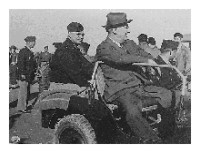-
Timeline - The 1950s
It was a time for chickens in every pot, two cars in every garage, color television, another war, and a space race to the stars.
More 1900s

View of Disneyland in 1956.

Rosa Parks transit bus now on display at the Henry Ford Museum, a National Historic Site, in Dearborn, Michigan.
Timeline Book

Now in easy to search digital format for your Kindle, Nook, or pdf format. Also comes in paperback, too.
ABH Travel Tip

A visit to Eisenhower National Historic Site should not be missed if you are visiting Gettysburg. Its home and farm evoke the time of the general and his wife, with period furnishings and tales of not only his presidency and the meetings with world and national leaders at the farm, but his life in Gettysburg and prior to that, in World War II. The farm was the only home Eisenhower owned in his lifetime.
Sponsor this page. Your banner or text ad can fill the space above.
Click here to Sponsor the page and how to reserve your ad.
-
Timeline
Detail - 1953
December 30, 1953 - The first color televisions go on sale.

Even though the advent of color television, or even color television still images, had been in development for a decade and more, the competing interest for whether the color be adaptable to existing black and white televisions, or that, for the most part, black and white and color broadcasts had to be able to be seen on "convertible color" sets was the bain of manufacturers, but important to the Federal Communications Commission (FCC). Systems had been in development from the late 1920's; John Logie Baird from Scotland with a mechanical systems that used a Nipkow Wheel. Bell Labs had a similar system. However, over the next ten years, the FCC was more interested in developing and approving a monochrome, black and white, television standard. In 1940, the FCC established the NTSC, the National Television Systems Committee, to approve just that, a unified black and white system.
But manufacturers and television entities kept working on a color system for the future, including CBS and RCA in the United States. CBS had been making a series of demonstrations in 1940 under their engineer Peter Goldmark. It did not meet the RCA black and white standard, which CBS hoped would be withheld by the FCC. However, the FCC approved the RCA standard for black and white in 1941, the 525 NTSC line system. Then came World War II and further development stalled.
After the war, it would take several years for the development of color television to mature. There were already eight million black and white sets in use. The first color television broadcast was an episode of Kukla, Fran, and Ollie on October 19, 1949. Of course, only those at the FCC could see it. The FCC denied it. They were convinced that the ten million sets already in use, black and white, should not be made obsolete, and although this compatible color system attempted in that direction, it was not good enough. CBS eventually had its system approved on October 11, 1950, but it was gangly, requiring a color wheel, and did not meet the black and white standard. It was low resolution and had a flicker, although the pictures were good.
"The CBS system did not labor under these handicaps. The quality of the color picture was of a high order. A wide variety of subject matter was displayed involving many different colors. Broadcasts were made from studios and from outdoors. In all instances color rendition was of a high quality. The equipment utilized was easy to operate. At not a single demonstration was there any evidence of mis-registration or inaccurate color. The CBS system does have fewer lines per picture than the present system. However, the addition of color to the picture more than outweighs the reduction in lines so far as apparent definition is concerned. You only have to look at a scene in color and compare the same scene in black and white to be convinced that the addition of color increases several-fold the amount of information that can be transmitted by a picture," Wayne Coy, Chairman of the FCC, September 1950."
RCA sued the FCC for approving it. The Supreme Court upheld CBS in its ruling against RCA. However, publicity during those months allowed the public to know that buying a CBS set that was incompatible with the black and white broadcast standard raised their market share of sales of RCA black and white sets by fifty percent. With that time, RCA also developed its color system that could be approved (previous attempts were not up to clarity and color standards), which used an electronic system the FCC approved on December 17, 1953, NTSC Color. That system is basically the same used today.
On August 30, 1953, another episode of Kukla, Fran, and Ollie became the subject of another test, using the NTSC color system. The National Production Authority had dropped its ban on the manufacture of color televisions earlier that year when CBS stated they were dropping their plan for their own color system. Now, that new color episode was still only viewable in the NBC studio. On October 31, 1953, the first network color broadcast, the Opera Carmen, went over the air as a broadcast. On January 1, 1954, the first national broadcast in color went over the air, the Tournament of Roses Parade. But how many people actually had a unit during those last months prior to true availability? Not sure. However, RCA had rushed two hundred prototype sets to their dealers so they could watch the parade.
On the same day as the parade, 15 inch color television sets, the RCA CT-100 and Admiral C1617A, went on sale. The Admiral Tv had been announced for sale on on December 30, 1953. First sold on January 6, 1954. There are so many dates to just when each company, even beyond RCA and Admiral, sold their first sets. However, companies such as Raytheon, AMC, and Westinghouse were in the market quickly. For the most part, it took until the spring for production to make the sets available to stores for sale. By 1955, sets came in 21 inch styles.
How Did The Public and Industry Respond?
Well, of course they had grown used to loving their televisions, although only half of United States households had the black and white version. The price of color televisions was high, $1,000 for the RCA CT-100 (four thousand were produced), and $1,175 for Admiral's C1617A. Yes, they were only for the rich and the advocates. Remember, television in the 1950's was just getting up to speed with networks capable of making programs in black and white. There were very few programs made in color into the 1960's. In Time Magazine's opinion on color television, "the most resounding industrial flop of 1956." However, they had, as of 1955, sold four hundred thousand units with the model variety a staggering one hundred and fifty. By the end of the 1950's, this competition had brought the price down to $500. There are other sources that state that only one hundred and fifty thousand had been sold by 1957. Perhaps they worked for Time Magazine. Ha!
However, there was still limited programming in color. NBC boasted five hours of color programming in May 1954. In 1959, the first color western came through the growing number of sets, Bonanza. The change to color television sets was still slow with only a 3.1 percent share of the market by 1964. It took until 1968 for the three major networks, ABC, CBS, and NBC, to finally make most of their programs in color. Color television sales did not surpass black and white model sales until 1972.
Image above: Montage (left) One of first two televisions available for sale, in 1954, by RCA, RCA CT-100, author unknown. (right) first color photo on a television, actress Patty Naismith, 1941, John Logie Baird. Courtesy Wikipedia Commons. Image below: Advertisement for Admiral Color Television Set, 1950's, visions4netjournal.com. Source Info: "65 Years Ago Today: The First Color TVs Arrive," 2018, Stewart Wolpin, soundandvision.com; "When did the first Color TV Sold," colorwithleo.com; "Early Color Televisions," earlytelevision.org; Wikipedia Commons.

History Photo Bomb
About
America's Best History where we take a look at the timeline of American History and the historic sites and national parks that hold that history within their lands.
Photos courtesy of the Library of Congress, National Archives, National Park Service, americasbesthistory.com & its licensors.
- Contact Us
- About
- © 2025 Americasbesthistory.com.
Template by w3layouts.


